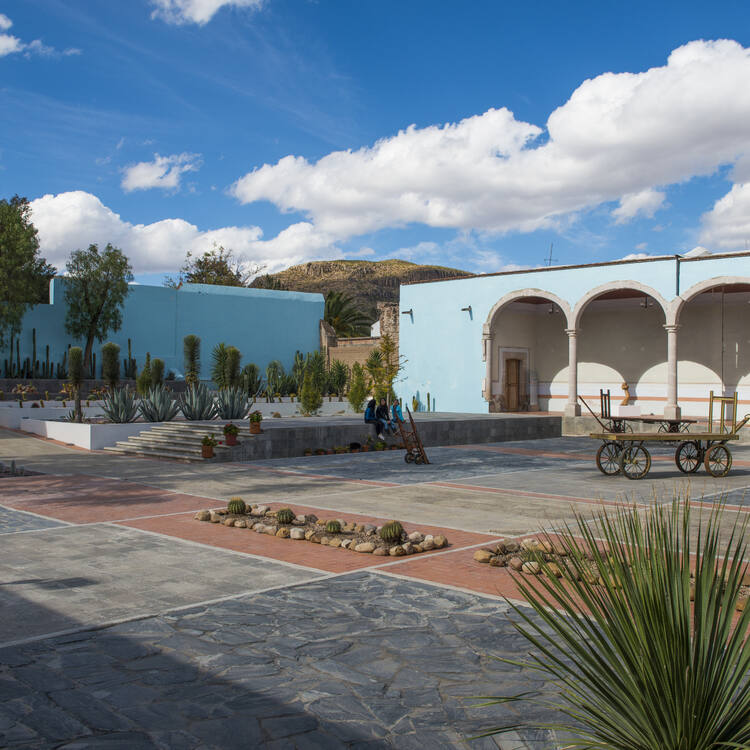Camino Real de Tierra Adentro
Camino Real de Tierra Adentro
Camino Real de Tierra Adentro was the Royal Inland Road, also known as the Silver Route. The inscribed property consists of 55 sites and five existing World Heritage sites lying along a 1400 km section of this 2600 km route, that extends north from Mexico City to Texas and New Mexico, United States of America. The route was actively used as a trade route for 300 years, from the mid-16th to the 19th centuries, mainly for transporting silver extracted from the mines of Zacatecas, Guanajuato and San Luis Potosí, and mercury imported from Europe. Although it is a route that was motivated and consolidated by the mining industry, it also fostered the creation of social, cultural and religious links in particular between Spanish and Amerindian cultures.
Description is available under license CC-BY-SA IGO 3.0
Camino Real de Tierra Adentro
Le Camino Real de Tierra Adentro était la route royale intérieure, également connue sous le nom de Route de l'argent. Le bien inscrit, qui se compose de 55 sites et de cinq autres déjà inscrits sur la Liste du patrimoine mondial, concerne une section de 1400 km de cette route d'une longueur totale de 2600 km qui partait du nord de Mexico pour se prolonger jusqu'au Texas et au Nouveau-Mexique, aux Etats-Unis. Cette route, utilisée de la moitié du 16e au 19e siècle, servait principalement à convoyer l'argent extrait des mines de Zacatecas, de Guanajuato et de San Luis Potosí et le mercure importé d'Europe. Bien qu'elle doive son existence et sa consolidation à l'industrie minière, cette route favorisa aussi la création de liens sociaux, culturels et religieux, en particulier entre les cultures espagnole et amérindienne.
Description is available under license CC-BY-SA IGO 3.0
كامينو ريال تييرّا أدِنترو
كان كامينو ريال تييرّا أدِنترو هو الطريق التجاري الداخلي المعروف أيضاً باسم "سوق الفضة". ويشمل هذا الممتلك، الذي يتألف من 55 موقعاً، إضافة إلى خمسة مواقع أخرى تم إدراجها في قائمة التراث العالمي، جزءاً يبلغ طوله 1400 كيلومتر من هذا الطريق الذي يصل طوله إلى 2600 كيلومتر، ويبدأ من شمال المكسيك، ويمتد حتى تكساس ونيومكسيكو في الولايات المتحدة الأمريكية. وكان هذا الطريق، الذي اُستخدم من القرن السادس عشر وحتى القرن التاسع عشر، مخصصاً، بصورة أساسية، لقوافل حراسة الفضة المستخرجة من مناجم زاكاستيكاس وولاية جواناجواتو وسان لويس بوتوسي، إضافة إلى الزئبق المستورد من أوروبا. ورغم أن هذا الطريق قد أنشئ وتعزز بفضل صناعة المناجم، فإنه شجّع إقامة صلات اجتماعية وثقافية ودينية، لاسيما فيما بين الثقافات الإسبانية وثقافات هنود أمريكا.
source: UNESCO/CPE
Description is available under license CC-BY-SA IGO 3.0
皇家内陆大干线
“皇家内陆大干线”,又以“白银大道”而著称。这一遗产包括55处遗址,此外,它还包括5处已列入世界遗产名录长度达1400公里的的遗址。总长 2600公里的大干线,从墨西哥北部一直延伸到美国得克萨斯州和新墨西哥州境内。16至19世纪时,这条道路主要用于运输萨卡特卡斯、瓜纳华托和圣路易斯波托西等地出产的白银及从欧洲进口的水银。尽管建设及加固这条道路主要是为了满足采矿业的需要,但实际上它也促进了各地之间,特别是西班牙与美洲之间社会、文化与宗教的联系。
source: UNESCO/CPE
Description is available under license CC-BY-SA IGO 3.0
Камино Реал-де-Тьерра Адентро
Камино Реаль-де-Тьерра Адентро была королевской дорогой, соединявшей внутренние регионы страны, и известной также под названием «серебряного пути». Этот исторический памятник, куда входят 55 поселений и пять других, уже включенных в Список всемирного наследия, расположен на участке длиной в 1400 км. Общая же протяженность дороги составляет 2600 км – от северной Мексики до Техаса и Новой Мексики в США. С середины шестнадцатого по девятнадцатый век эта дорога была оживленным путем транспортировки серебра, добывавшегося в копях Закатекаса, Гуанахуато и Сан-Луис-Потоси, и ртути, доставлявшейся из Европы. Созданная и развитая для удовлетворения нужд горнодобывающей промышленности, эта дорога также содействовала установлению общественных, культурных и религиозных связей, в особенности, между испанской и индейской цивилизациями.
source: UNESCO/CPE
Description is available under license CC-BY-SA IGO 3.0
Camino Real de Tierra Adentro
El Camino Real de Tierra Adentro, también conocido por el nombre de “Camino de la Plata”, comprende cinco sitios ya inscritos en la Lista del Patrimonio Mundial y otros 55 sitios más situados a lo largo de 1.400 de los 2.600 km de esta larga ruta que parte del norte de México y llega hasta Texas y Nuevo México, en los Estados Unidos. Utilizado entre los siglos XVI y XIX, este camino servía para transportar la plata extraída de las minas de Zacatecas, Guanajuato y San Luis Potosí, así como el mercurio importado de Europa. Aunque su origen y utilización están vinculados a la minería, el Camino Real de Tierra Adentro propició también el establecimiento de vínculos sociales, culturales y religiosos entre la cultura hispánica y las culturas amerindias.
source: UNESCO/CPE
Description is available under license CC-BY-SA IGO 3.0
ティエラアデントロの王の道
カミーノ・レアル・デ・ティエラアデントロは「大地にある王の道」という意味で、「銀の道」としても知られる。この道はメキシコシティから米国のテキサス、ニューメキシコへと2600㎞にわたって延びており、そのうちの1400㎞の距離の範囲に55の遺跡と、すでに登録されている5つの世界遺産が点在している。この道は主にサカテカス、グアナファト、サンルイスポトシの鉱山で採掘した銀やヨーロッパから輸入した水銀を輸送するため、16世紀半ばから19世紀まで300年にわたり交易路として利用され、また、スペインとアメリカ先住民文化の間に社会的、文化的、宗教的交流を育んだ。source: NFUAJ
Camino Real de Tierra Adentro
Camino Real de Tierra Adentro was de Koninklijke weg, ook wel bekend als de Zilverroute. Het gebied bestaat uit 55 regio’s en vijf bestaande Werelderfgoedgebieden die liggen langs 1.400 van de 2.600 kilometer lange route, die zich uitstrekt van Mexico Stad tot Texas en New Mexico in de Verenigde Staten van Amerika. De route werd van halverwege de 16e tot de 19e eeuw actief gebruikt voor het vervoer van zilver uit de mijnen van Zacatecas, Guanajuato en San Luis Potosí en van kwik uit Europa. De Zilverroute heeft ook bijgedragen aan sociale, culturele en religieuze banden, in het bijzonder tussen de Spaanse en Indiaanse culturen.
Source: unesco.nl
Outstanding Universal Value
Brief synthesis
The Camino Real de Tierra Adentro constitutes a part of the Spanish Intercontinental Royal Route from Mexico City to Santa Fe. The property, consists of five existing urban World Heritage sites and 55 other sites related to the use of the road, such as bridges, former haciendas, historic centres/towns, a cemetery, former convents, a mountain range, stretches of road, a mine, chapels/temples and caves within a 1,400 km stretch of the road between Mexico City and the Town of Valle de Allende. The Camino was an extraordinary phenomenon as a communication channel. Silver was the driving force that generated the wealth and commitment of the Spanish Government and the will of colonists to ‘open up’ the northern territory for mining, to establish the necessary towns for workers and to build the forts, haciendas, and churches. The outcome of this highly profitable process was the development of mines, and the construction of the road and bridges, the establishment of multi-ethnic towns, with elaborate buildings that reflect a fusion of Spanish and local decoration, an agricultural revolution in the countryside centered on large hacienda estates with churches, and the movement of peoples up and down the road, facilitated to a great degree initially by settlements of muleteers, all of which led to the development of a distinctive culture along the route. Ultimately the wealth of silver led to massive economic development in Spain and other parts of Europe and a period of great economic inflation. The impact of the road was enormous in terms of social tensions as well as ultimately social integration between the many people that came to be involved in the economic development. The structures in the property together reflect some aspects of this interchange of ideas and people along the southern stretch of the road.
Criterion (ii): The Camino Real de Tierra Adentro became one of the most important routes to bond the Spanish Crown with its northern domains in the Americas. Along the southern part of the route is a collection of sites related to work in mines and haciendas, merchant trading, military, evangelism and the administrative structure designed to control the immense territory from the Spanish metropolitan hub, adapted to the local environment, materials and technical practices, that reflect an outstanding interchange of cultural and religious ideas.
Criterion (iv): An ensemble of sites along the southern part of the Camino Real de Tierra Adentro, including examples of buildings, architectural and technological ensembles, illustrate a significant stage in human history - the Spanish colonial exploitation of silver and the transformation of associated rural and urban landscapes.
Integrity
The component parts of the serial nomination illustrate the variety and diversity of functions and physical components that reflect the impact of the Camino Real de Tierra Adentro. Some of the parts are vulnerable to inadequately controlled development, particularly of new roads, the disturbance of landscape settings, and physical neglect of fabric.
Authenticity
The specific way individual components reflect the overall impact of the road need to be set out more clearly in order that their individual contributions can be better reflected and understood, particularly in the case of existing inscribed World Heritage properties.
Management and protection requirements
Considerable legal protection is in place at federal, state and local levels. In terms of archaeology, the sites and particularly the road itself are less well protected. The conservation condition of most of the 60 nominated properties is generally good.
Management arrangements exist at federal level, trough the National Institute on Anthropology and History (INAH), and at state level in each of the ten states concerned. The management systems for the majority of the components are adequate and the overview role of the INAH is appropriate. Although there is no overall coordinated formal management framework for all components, the National Conference of Governors has committed to support the project of the Camino Real de Tierra Adentro through the formation of a coordinating work group.
There is a need to define and protect the setting of the nominated sites beyond the proposed buffer zones when related to landscape structures; to put in place legal protection for all the individual sites; and to establish an overall coordinated management system that encompasses all the sites.


